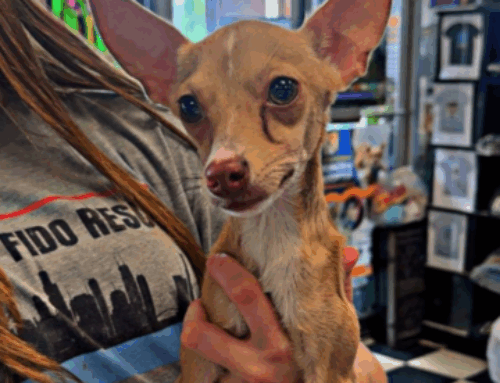Author:
Gloria Lissner
Category:
How Compassionate Animal Care Serves the Community

Chicago is a model city for urban growth, business, invention, architecture, and quality of life. Unfortunately, our beautiful city has not been a model for compassion, especially regarding companion animals – dogs and cats. Despite our reputation for progressive ways of thinking, under current laws, companion animals like dogs and cats are considered property: commodities that are bought, sold, treated, bred, and traded by people as they see fit. This leads to a perpetual cycle of people breeding and abandoning their dogs and cats to die in shelters.
At Famous Fido Rescue and Adoption Alliance, we not only rescue animals, but we also advocate on behalf of them to win the rights to which they are entitled. We are promoting the passage of a Compassionate Care Act to protect the rights of animals and improve the state of our community overall. The Compassionate Care Plan centers on stopping the cycle of dog and cat overpopulation in shelters to prevent the unnecessary killing of millions of companion animals each year. We have done the same things the same way, and the number of animals killed in shelters has continued to climb. The Compassionate Care Plan encourages a change in our community’s way of thinking and behaving to stem the flow of animals to kill and no-kill shelters.
You may have noticed a difference in standard language in the paragraphs above. Instead of using terms like “owner” and “pet,” what if we started using “guardian” and “companion”? We use these terms to emphasize our responsibility to companion animals as sentient beings who are able to feel emotions and pain just like you and I can. What if we stopped using the term “euthanasia” and started using “killing” instead? The term “euthanasia” comes from the Greek roots eu “well” + thanatos “death” and translates roughly to “easy death.” For our companion animals, though, these deaths are anything but easy. Do you see how uncomfortable it becomes to think about killing our companion animals? It is this change that leads to the reforms we propose in the Compassionate Care Plan.
Spaying and Neutering Education: The cycle of killing begins with indiscriminate breeding by unlicensed guardians. In some cases, guardians perceive spaying and neutering as harmful when, in fact, these procedures can protect dogs and cats from reproductive cancers. In other cases, an outdated understanding of veterinary science has led people to think that female dogs “need” to have at least one litter of puppies, fueling overpopulation in shelters. Furthermore, some guardians believe that spaying and neutering are unaffordable. However, places like PAWS and Anti-Cruelty Society run low-cost spay and neuter clinics. One of our key proposals in the Compassionate Care Plan is to provide private and public funding to educate people and to expand the number of clinics in Chicago and the surrounding suburbs.
Prohibitions on Backyard Breeding: A backyard breeder is an unlicensed private citizen who deliberately breeds dogs and cats to make money on the side or simply fails to neuter or spay their family dogs and cats, allowing them to breed indiscriminately. This problem is more significant than most people realize: casual and small-scale operations of backyard breeding account for the sale of two-thirds of the fifty-three million dogs in the United States. Many of these animals live in filthy, disease-ridden conditions and often lack proper shelter and food. Backyard breeders do not educate or screen dog or cat buyers. Puppies and kittens may be placed in abusive homes. Unprepared buyers take them home and may quickly tire of the commitment to their companion animal, dropping the family dog or cat off at a shelter after the novelty wears off. Stiff fines and penalties for unlawful backyard breeders will halt the unchecked flow of animals from these sources and lead to a drastic reduction of intakes at animal shelters.
Microchipping: Lost dogs and cats contribute significantly to the shelter population. Sadly, only 15% of lost dogs and 2% of lost cats are actually returned to their guardians because people do not take precautions with identification. Because tags and collars can be easily lost, microchipping is the most effective way to ensure lost animals are reunited with their guardians. This procedure is inexpensive and causes very little pain to the animal. Some places offer microchipping procedures at special events for even cheaper than the market rate. The way to curb the killing of family companion animals is to enact a law requiring microchip implantation much as rabies vaccines are mandated. Lost dogs and cats can then be safely and happily reunited with their families.
Adoption Screening: Uninformed, unprepared guardians are allowed to take home dogs and cats from some shelters every day. Worse yet, some adopters turn out to be animal abusers/abandoners or backyard breeders themselves. These animals are often put out on the street to fend for themselves: lonely, ill-prepared, and frightened. Many will be picked up and sent right back to a shelter, perpetuating the cycle of overpopulation and killing. The Compassionate Care Act encourages effective screening and counseling of potential adopters, leading to a higher retention rate of companion animals and a significant decrease in animals’ reentry into the shelter system.
Guidelines for “Owner Surrender”: We need to think of companion animals as members of the family, not as pieces of property to be easily acquired and discarded at will. Every day, guardians abandon thousands of companion animals by taking them to shelters. This is called “owner surrender,” and in many cases, these guardians actually believe they have done the best thing for their companion animal. They comfort themselves with the fantasy that their dog or cat will find a loving home, a “better fit” than with their family.
People who tell themselves this must realize that is far from the truth. According to the American Society for the Prevention of Cruelty to Animals, of the 6.5 million animals who enter the U.S. shelter system each year, 1.5 million are killed. These numbers are impossible to confirm with certainty; the number is believed to be much higher. Furthermore, 10% of animals that are adopted from a shelter are no longer in their new home six months after adoption. Astonishingly, even though advice and counsel from family, friends, and veterinarians make it three times more likely for a guardian to retain a dog or cat, no counseling is provided before a guardian surrenders an animal. The Compassionate Care Plan encourages counseling to educate people and provide resources to help them retain the family dog or cat.
Stop Violence Against Animals: Society has a duty to stop the abuse of both humans and animals. Dogs and cats depend on their guardians to feed and shelter them. Acts of violence against animals are acts of violence against the community itself. A compassionate, enlightened society requires its members to fulfill their obligations and does not allow living beings to suffer and die. To ignore violence of any kind is to accept and sanction it within the community. This is not the type of world we want our children to grow up in.
Even people who are not animal lovers must realize how important it is to detect and stop the cycle of violence against animals. We know that domestic abuse perpetrators begin by abusing the family dog or cat first before escalating unpunished abusive acts to human beings. While child abuse is often hidden from the neighbors, animal abuse has less shame attached to it and is often witnessed by a neighbor. Therefore, appropriate legislation to punish those who abuse and neglect companion animals ensures that authorities will be able to investigate all allegations and evidence of violence. While this is critical to protecting animals, it also provides a means by which authorities can investigate other domestic violence issues, such as abuse and neglect of children and the elderly. If the abuse and neglect of the family dog or cat can be investigated and stopped, fining and arresting the perpetrators, this may help keep children and the elderly safe from would-abusers.
Education Programs at Home and Schools: Children must be educated in the care and respect of animals. Without careful instruction, children may end up approaching an animal in a way that causes them to be harmed. Putting a hand or face in a dog’s face may encourage that animal to bite out of surprise or misunderstood intent. After all, a dog cannot use words to tell you how to approach him. Picking up or aggressively petting a cat may cause her to scratch in self-defense because she cannot use words to tell you she dislikes what you are doing. Children are often over-exuberant in handling animals and end up sustaining easily avoidable injuries. A little education can prevent both injury and owner surrender.
If parents do not have the time or energy to teach compassion and respectful approach of animals, then schools must do so. Many schools already have anti-bullying initiatives in place. Just as children must learn not to join in with a school bully attacking another child and to report the incident to a trusted adult, so, must children be taught to report animal abuse and torture. Aside from fulfilling our obligation to protect and defend all life, the community must realize that many children who torture animals have suffered abuse themselves or may have a serious psychological condition. We must set up programs where children and adolescents who have abused animals receive counseling and treatment so the cycle of violence is not permitted to continue.
The first step towards learning to value life – all life – is never to abuse or condone the abuse of any person or creature. Children learn from the actions and words of their parents and other family members. If they observe the easy acquisition and subsequent discard of a dog or cat, this teaches them that life is expendable and that empathy is not an essential value in the family. Without models of compassionate, empathetic behavior, children may learn the wrong lessons about how to treat others.
It is a lack of compassion that leads to acts of violence such as bullying, abuse, and neglect. Unfortunately, our society has promoted technology at the expense of compassion. Companion animals are beings who cannot be deleted from social media feeds or blocked from friends lists. They are lifetime commitments, not objects to be thrown away when their guardians decide they want “newer” or “better” companion animals. Compassion is not a finite resource. When properly cultivated in others, empathy leads to societal and community improvement.
When we talk about the Compassionate Care Plan and a new way of thinking and problem solving, it is with all of these elements in mind to help shape a kinder, more compassionate and ethical society that honors its obligations and commitments to all beings. The old way of thinking about our relationship with animals has not worked, nor have our methods to attempt to reduce the overpopulation of companion animals been successful. Now is the time to change our attitudes, language, and practices to change our society and protect the sanctity of all life.





